
The Perfect Template
Ever wonder how woodworkers drill those odd-angled, perfectly placed leg holes on the underside of chairs and stools and some tables? The answer is a custom drilling template that can be used over and over for dozens of identical furniture pieces. It doesn’t take long to make a drilling pattern. And once it’s finished, you just clamp it on the seat-to-be, drill through the holes, trace the pattern onto the stock, cut it out and glue in the legs.
How to Make this Pattern
Step 1: Create the guide holes
Glue and screw together two pieces of 3/4-in. MDF with 1-1/4-in. screws. Set a drill press to the desired leg angle, and drill guide holes so they come out at the proper hole locations on the seat top with a Forstner bit sized to the corresponding holes in the seat.
Step 2: Cut the seat shape
Cut the shape you want and clamp it to the seat stock and drill the holes (use a piece of plywood underneath to avoid tear-out). Then trace around the pattern and saw out the seat.
Step 3: Drill holes into the seat
Use a Irwin Speedbor bit to drill the seat holes; the guide hole will keep it perfectly angled while you’re drilling. These Irwin auger-style bits are very aggressive, so set the drill at a slow speed and practice on a scrap board so you don’t wreck your artwork. Check out these must-have drill attachments too!
Click here to buy a 1-in. Irwin Speedbor bit from Amazon.
13 Dirt-Simple Woodworking Jigs You Need
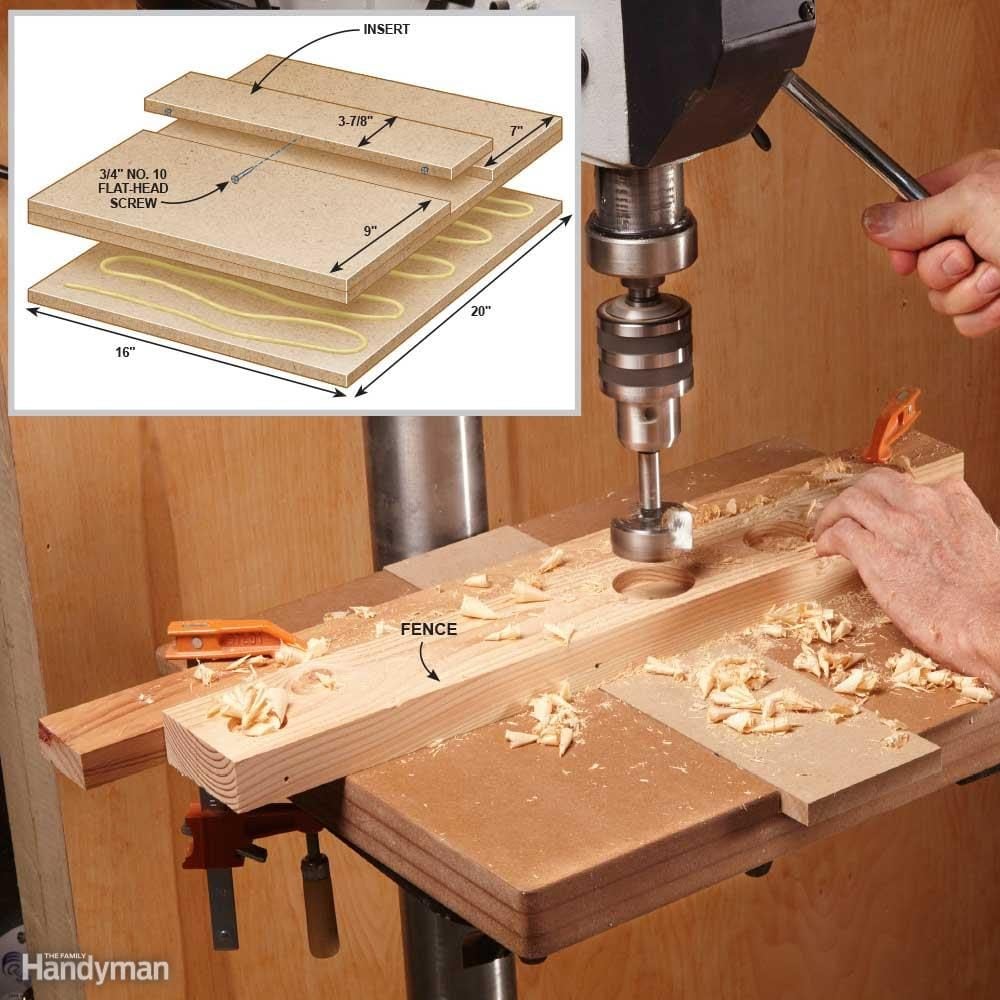
Drill Press Table
Many drill press tables are too small for woodworking because they were designed for metalworking. Also, standard drill press tables don't have a fence or an insert to back up holes drilled all the way through a piece of wood. This jig solves these problems! Make the table from three layers of 1/2-in. medium-density fiberboard glued together. It's fastened to the machine's table from underneath with four lag screws. The table's top layer is composed of three pieces. The outer pieces are glued to the table, while the center piece—the insert—is loose. The insert is 1/8 in. narrower than the gap between the two outer pieces. Install three flat-head screws in the side of the insert and adjusted them so the insert fits snug in the gap. When you need a fresh surface to drill into, slide the insert in or out, flip it around or flip it over. Also, make a few extra inserts so you can toss one away when it starts looking like Swiss cheese. The fence is just a plain board clamped to the table.
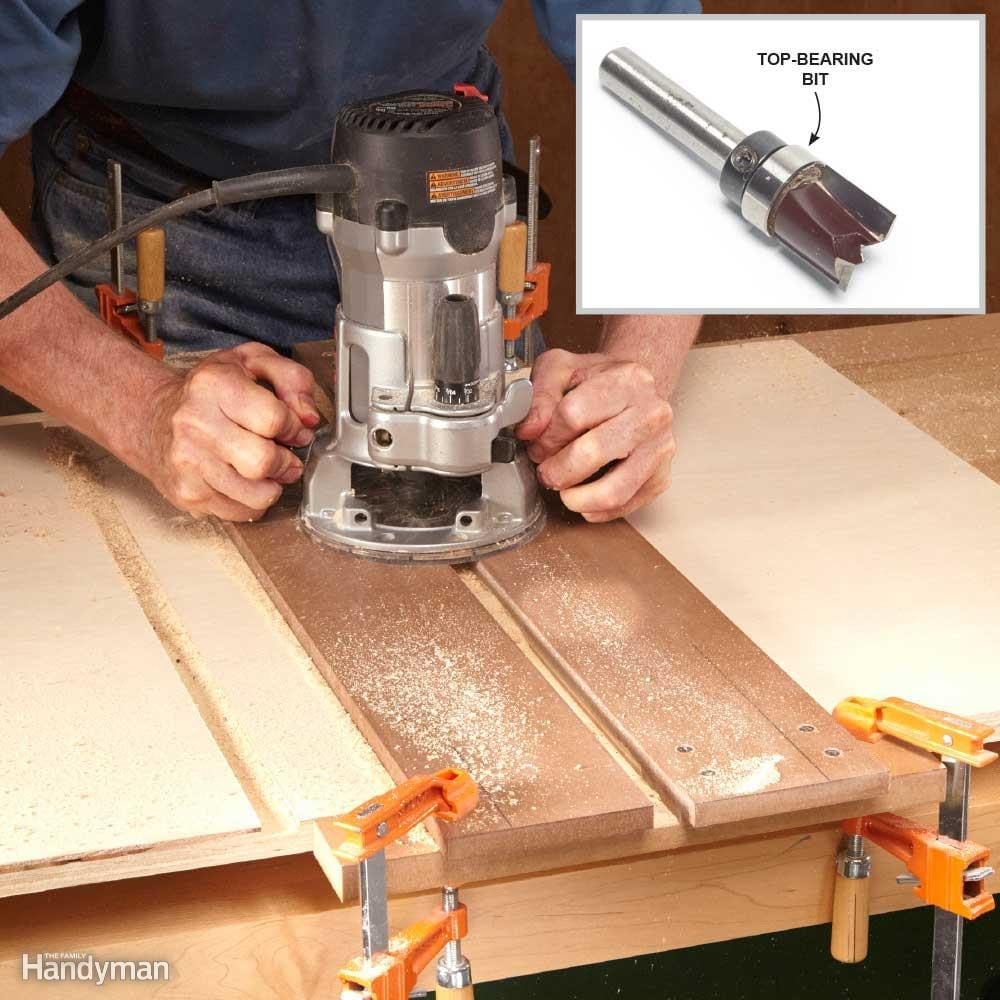
Jig for Routing Dadoes
When building a cabinet, dadoes are often used to ensure that shelves and partitions are spaced correctly. To make a strong joint, the width of the dadoes must exactly match the thickness of the plywood. That can be a challenge because few pieces of plywood are precisely 3/4 in. thick. They're usually 1/32 in. or so less than the “nominal” thickness. This jig will rout perfect-fitting dadoes for any piece of 3/4-in. plywood regardless of its actual thickness. Use a special top-bearing trim router bit with the jig. The bit is 1/2 in. wide, 1/2 in. long and has a bearing mounted above the cutter. The bearing is flush with the bit's cutting edges. This routing jig has two long, parallel guides made from 1/2-in. MDF. When you rout a dado, ride the bearing along one guide, then make a second, return pass and ride the bearing along the second guide. This way, the space between the guides determines the width of the dado. Setting up the guides is easy. One guide is fixed to the jig's 3/4-in. cross members; the other is loose and adjustable. Take two small pieces of the plywood and place them against the fixed guide. Then slide the adjustable guide against the pieces and clamp the guide to the cross members. Done!
Find out how to use a pocket screw jig, too, in the video below.


Sacrificial Table Saw Fence
When you have to adjust the table saw's fence so it sits right next to the blade, put a “sacrificial” fence on the saw. Using a sacrificial fence helps you avoid accidentally cutting into the real fence, which would be really bad news. This sacrificial fence is made of four thicknesses of 1/2-in. MDF glued together. (Threequarter- inch plywood would work just as well.) Cut the middle pieces into thirds in order to create holes for clamping. The holes ensure that the clamp's heads won't get in the way when you're making a cut. The beauty of this system is that you can use all sides of the fence until it wears out—but it's easy to make another!
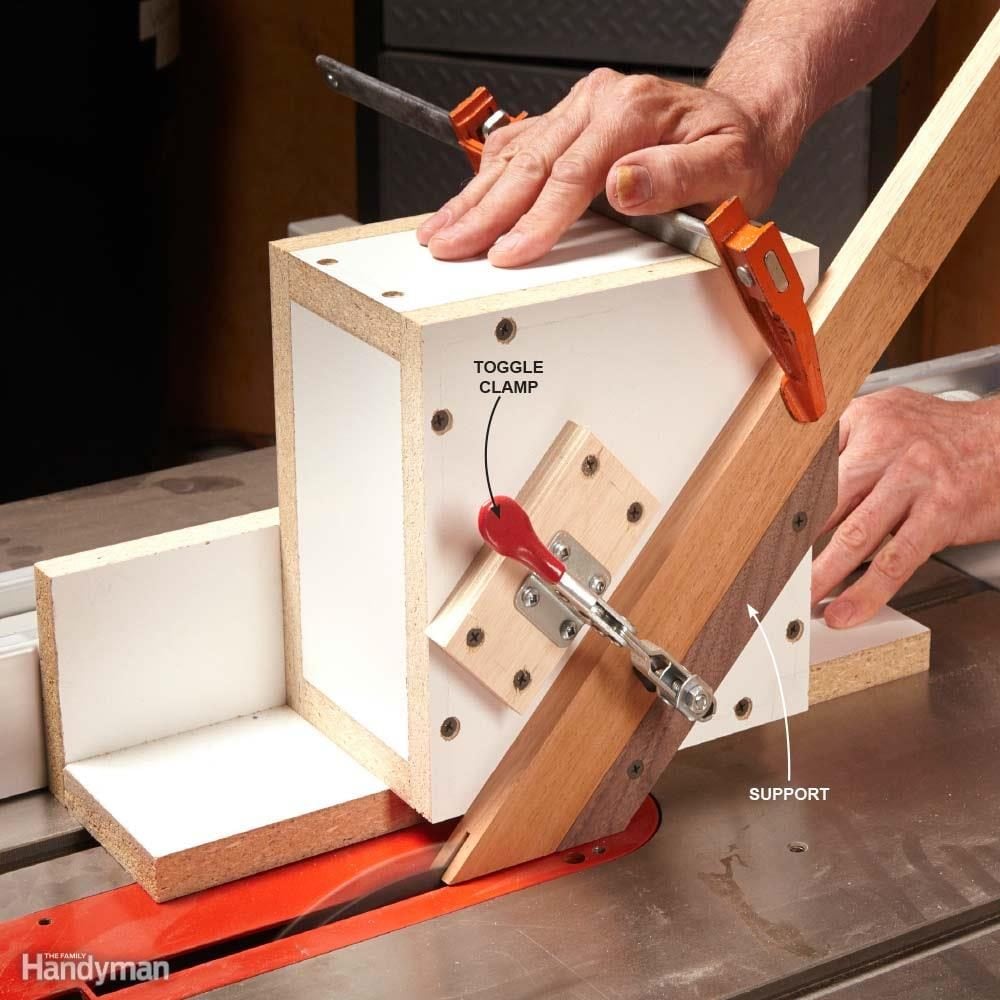
Table Saw Guide Box
When you have to stand boards on end to machine them on a table saw, pull out this simple box. It steadies the wood so you get a straight cut. The box is made of melamine and measures 8 in. square and 5-1/2 in. deep. It's screwed to two optional runners that are 12 in. long. Here, we show cutting slots into the ends of each part of a picture frame so the parts can be joined with spline (thin pieces of solid wood). You couldn't do this using the table saw's fence alone because the fence doesn't offer enough support—it's not tall enough. Using this box, you're sure to get an absolutely straight cut. The picture frame piece is supported by a block that's screwed to the box. If you need to support pieces at 90 degrees—for cutting tenons, for example—just remove the 45-degree support and screw on another. To ensure a straight cut, clamp the workpiece to the box. Use a toggle clamp to hold the frame's lower end because it's difficult to get a regular clamp down there. The table saw's fence gets in the way. You can buy a toggle clamp at a woodworking store or online.
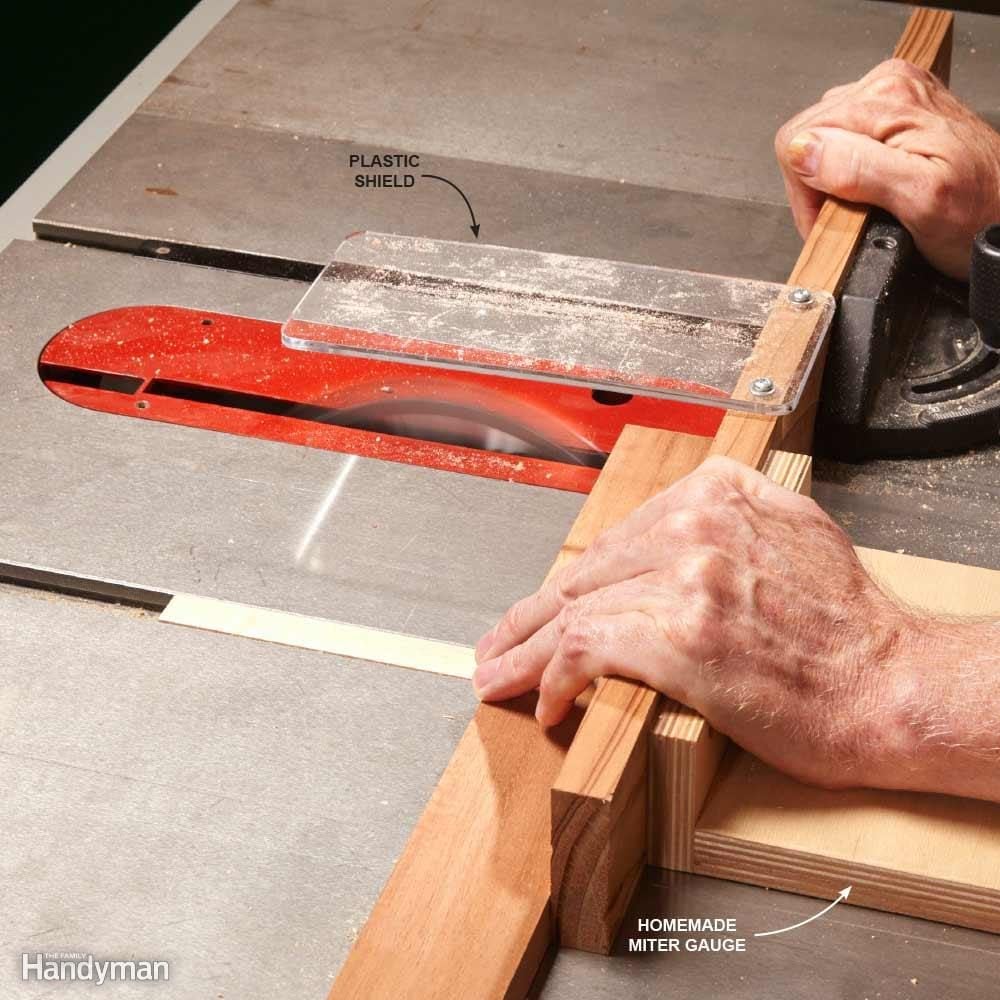
No-Wiggle Table Saw Crosscuts
If your miter gauge's bar wiggles in the saw's miter slot, you'll have a hard time getting an absolutely straight crosscut. Here's a way to fix that: Use two miter gauges connected by a fence. An extra miter gauge isn't very expensive, but you can cut the cost to zero by making one yourself. Glue two pieces of Baltic birch plywood together to form an L-shape body, then carefully cut a bar to fit snugly into your saw's miter slot. Use a piece of maple to make the bar, or 1/4-in. tempered hardboard is another good choice. Glue the bar to the body using spring clamps, so you can easily adjust the bar to be exactly 90 degrees to the body before the glue sets. Install screws later. You probably won't be able to use your saw's guard with this setup, so it's a good idea to add a plastic shield to the fence. The shield will remind you not to put your fingers too close to the blade and will keep the sawdust out of your eyes.
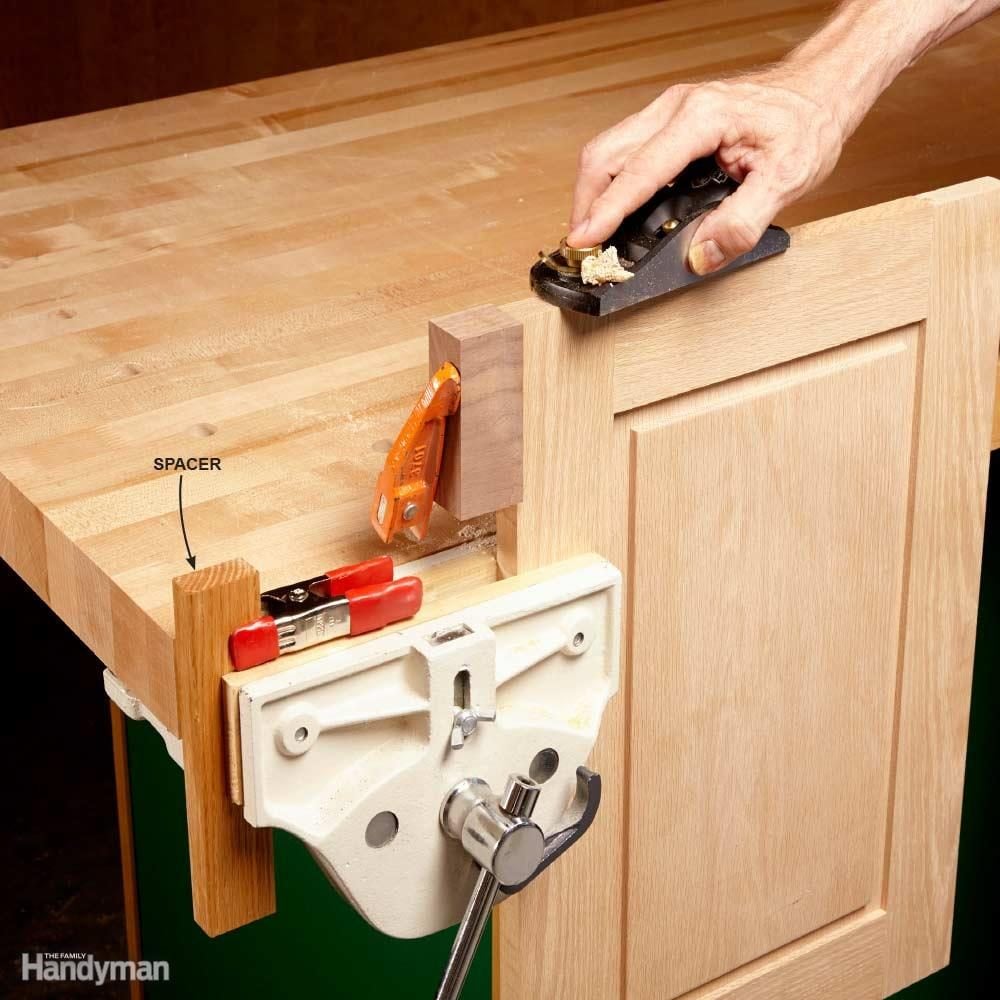
Boost Your Vise's Holding Power
When you clamp a board using only one side of your vise, have you noticed that the board often slips or rotates if you push down on it? That's because the vise's jaws don't stay parallel when the vise is tightened. Your board is getting pinched only along one edge. Even the best vises “rack” like this. Fixing the problem is quite simple. You just need to place a spacer on the opposite side of the vise. The spacer should be the same thickness as your workpiece—a scrap offcut works well. Drive a screw into one end of the spacer or pinch it with a spring clamp so you don't have to hold on to the spacer while tightening the vise.

Extra-Large Sander Table
Benchtop disc sanders come with small tables. If you need a larger table, make a new one and clamp it to the original table. At first you might think you'll add the extra-large table only when you need it, but once you put it on, you might never take it off! This jig is far fancier than it has to be—a plain piece of melamine would have sufficed.
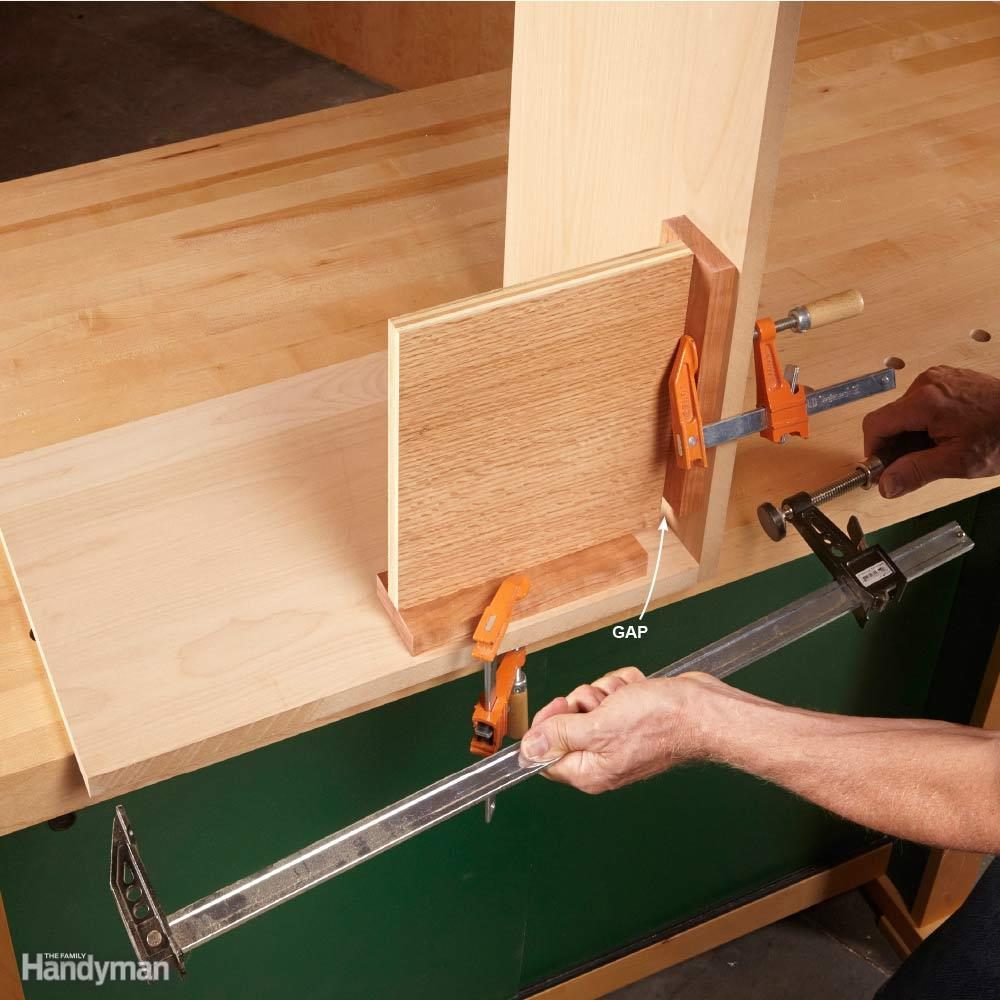
Squaring Blocks
A cabinet that's out of square is like a house built on a foundation that's not level. Good luck getting doors to hang right! When you glue and clamp up a case, use a couple of “squaring blocks” to make sure the case has 90-degree corners. Clamp the blocks to the case before putting the final squeeze on the case's clamps. This type of squaring block is very easy to make. First, cut a piece of plywood about 8 in. square. (Make sure the inside corner is truly square by testing it with a combination square.) Next, screw two 3/4-in. x 2-3/4-in. x 7-in. lips to adjacent sides of the block for clamping. Leave a gap at the inside corner of the block so you can remove glue that squeezes out of the joint.
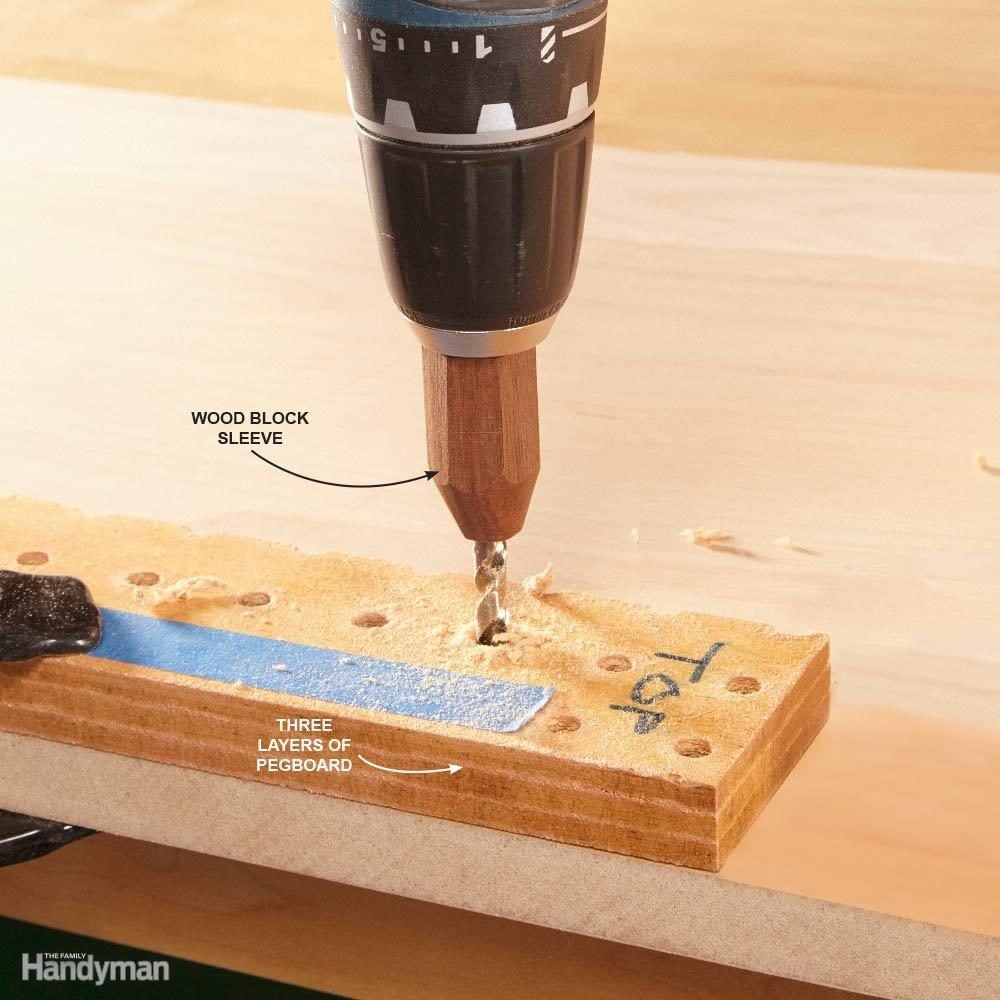
Three-Layer Hole Drilling Spacer
You may have seen this trick before—using a piece of pegboard to drill evenly spaced holes for shelf pins. But here's another take on it: Make the jig from three layers of pegboard. A thick jig has a couple of advantages. First, the holes won't wear out as fast (holes in a single layer of pegboard tend to become oval quickly). Second, the additional thickness will help keep your drill perpendicular to the panel. When using the jig, tape over the holes you don't need so you don't make a dumb mistake. Also, slide a wood block onto the drill bit to limit the hole depth. So, how do you keep the holes aligned when gluing the pieces together? It's really quite simple. Insert a couple of 1/4-in. machine bolts through opposite ends of the glue-up, then add washers and nuts. Tightening the nuts will force the pieces into alignment and keep them there. Trim the edges of the jig after the glue dries.
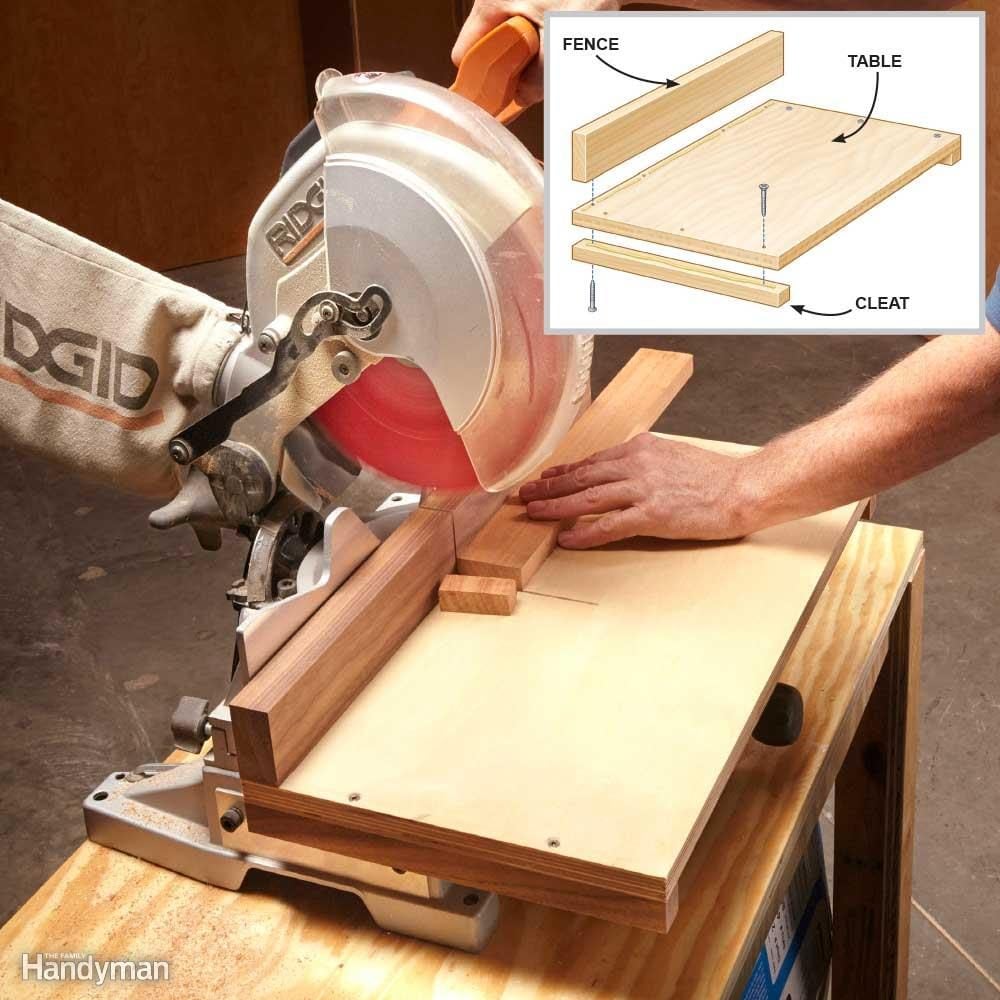
Accurate Miter Saw Cuts
Clamp this small Baltic birch table to your miter saw when you want to cut a few short pieces to an exact length. The slot in the table's fence shows you precisely where the blade will cut—just mark the piece with a pencil and line up the mark with the slot. The slot has “zero clearance,” meaning there's no gap on either side of the blade. The slot in the table is zero clearance too. Zero-clearance slots reduce tear-out to an absolute minimum, eliminating splintered edges. When this table was made, the fence was one long piece of wood. Cleats were screwed to the table's ends to lock the table in place. Then the saw was lowered to cut the slot in the fence. Note that the table must be wider than the saw's turntable—the uncut portion of the table is what holds it together!
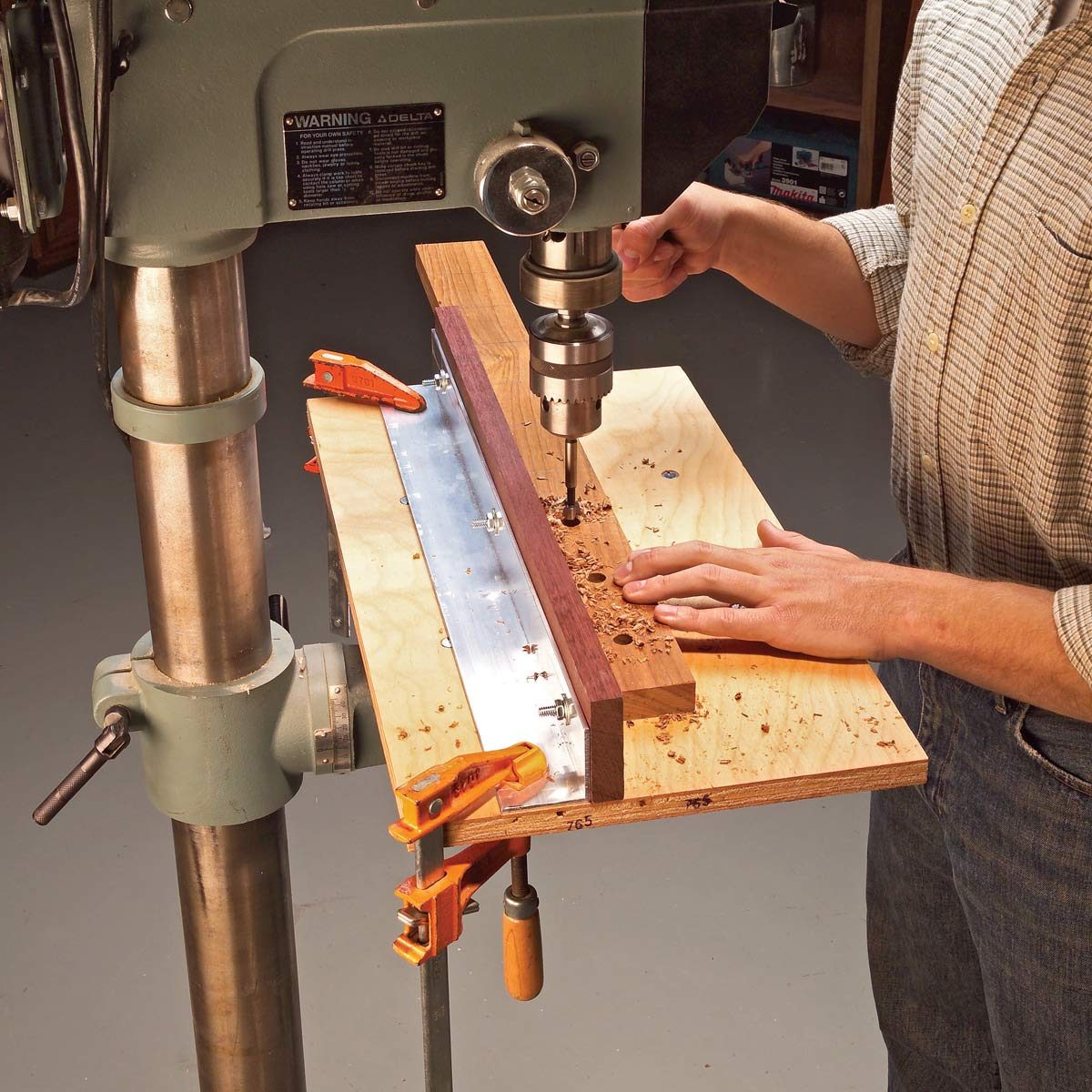
Adjustable Fence
Add an adjustable fence to your drill press to make it a lot handier for woodworking projects! A fence is especially useful for drilling rows of precisely placed holes. Also, boring holes in a small workpiece is a snap—just clamp the piece to the fence at any angle and drill the hole. You won’t struggle with holding small pieces in place while you drill. (That’s also dangerous!) 1. Attach a 2-ft. x 1-ft. scrap of plywood or particleboard to the drill press table with countersunk 1/4-in. flat head machine screws, fender washers and nuts. (Run the screws through the slots in the metal table. The fender washers will span the slots.) 2. Create the fence from a 2 ft. x 4-in. x 1-in. board bolted to a 2-ft. piece of 3-in. x 1/8-in. aluminum angle iron ($10 at a home center for a 4-ft. length). Again, countersink the holes in the board before bolting the board to the angle iron.

Vertical Drilling Jig
If you’ve ever tried to drill a perfectly straight and centered deep hole in the end of a board, you know that it’s nearly impossible with a handheld drill. But add a drill press and a jig and the job becomes very doable. Make this jig from two 8-in. x 12-in. pieces of 3/4-in. plywood or medium-density fiberboard (MDF). Just screw the pieces together to form a “T” and reinforce the jig with a couple of triangles. To use the jig, clamp it to the drill press table and the workpiece to the jig. Draw an “X” across the corners to find the exact center of the piece. You’ll have to adjust the height of the table and pivot it until you line everything up, but after that, drilling a straight, centered hole is a cinch. This trick will work for rectangular or square boards.
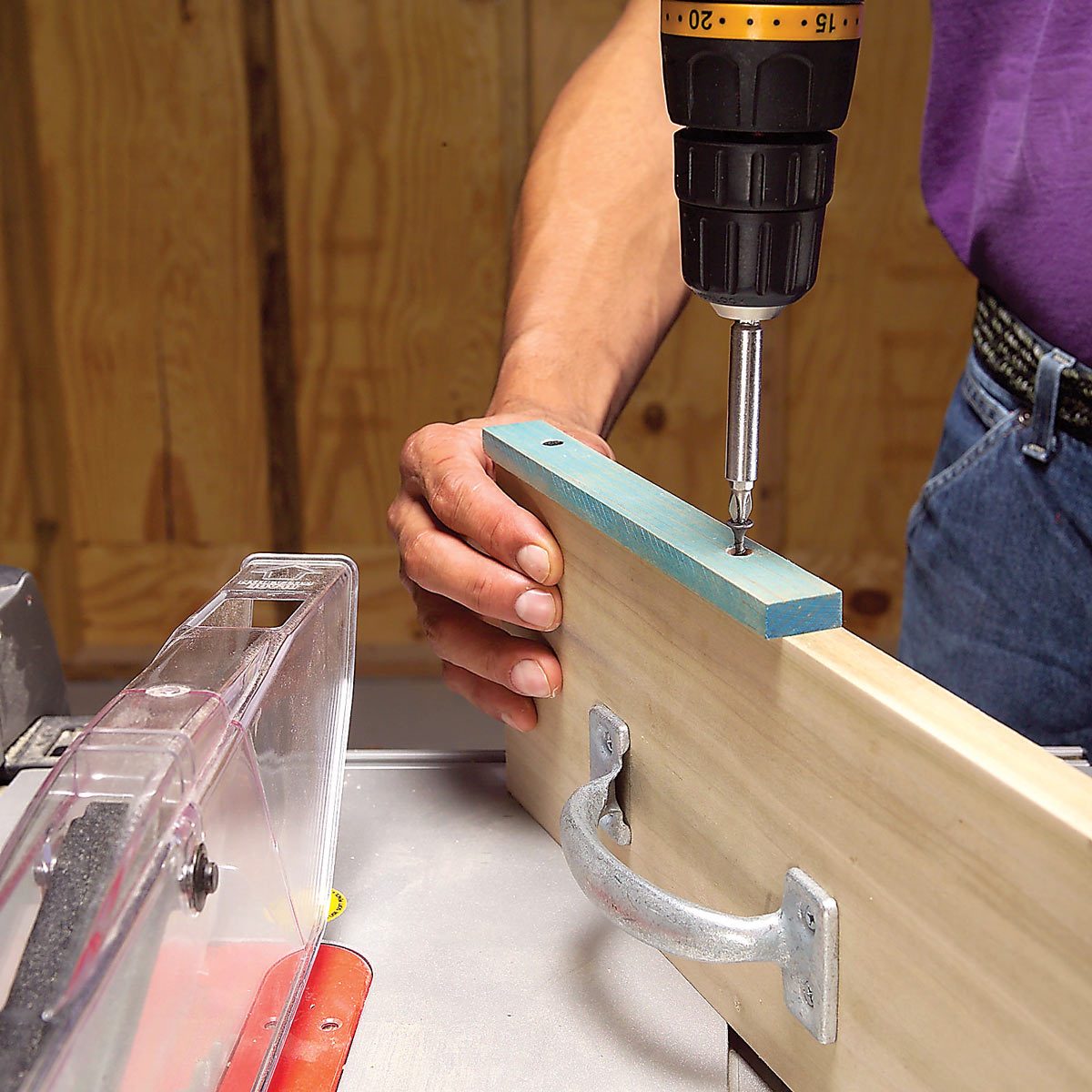
Cut Narrow Strips with a Sliding Jig
To make a series of identical narrow strips for shelf edging, you don't need to remove the blade guard or move the fence for every cut. Just attach a short strip of wood slightly thinner than the width of the rip cut to the end of a 4-ft. 1×6. Then hold the board against it and push the jig through. The jig keeps your hands well away from the blade, and you can rip as many pieces as you need without ever moving the fence. To make the jig, attach a 5-in.-long strip of wood, 1/16 in. narrower than the width of the desired rip, to the end of a 1×6 as shown. Basically you're creating a horizontal push stick. Add a handle near the end of the jig to give yourself better control as you run the jig through the saw.
https://www.familyhandyman.com















Comments
Post a Comment